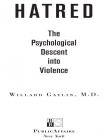Hatred, Willard Gaylin [best ebook for manga txt] 📗

- Author: Willard Gaylin
Book online «Hatred, Willard Gaylin [best ebook for manga txt] 📗». Author Willard Gaylin
The paranoid shift starts as a means of salvaging some self-respect out of humiliating circumstances. This shift allows the paranoid to view his misery as a product of the willful acts of some alien others. This shift allows the individual to view himself as a victim rather than a failure; guilt and fear are converted into rage, and shame is transformed into indignation. In the process, the individual is often transformed into a noble martyr chosen by God or some other higher source. It is this that links the delusions of persecution to the delusions of grandeur.
Sylvia Nasar in her biography of John Forbes Nash, Jr., a Nobel Prize winner in economics, presented an intriguing modern view of a paranoid schizophrenic.39 The successful movie adapted from the remarkable book made the workings of the paranoid mind—and the ways in which they are first incorporated into and eventually become destructive of the person’s life—understandable to a vast audience. Nash, a brilliant mathematician teaching at Princeton, was plagued with persecutory delusions, which led him to construct a complex view that placed him in a heroic struggle against evil, in which he was the secret agent of the CIA.
Freud’s attention was drawn to paranoia by the publication of another remarkable book. In 1903, Daniel Paul Schreber, a former presiding judge of the appellate court in Dresden, Germany, published his autobiographical book, Memoirs of a Neurotic. Freud, not being an institutional psychiatrist, had little access to patients suffering from “dementia paranoids,” the term then used. Freud had certainly treated patients that by today’s standards would be diagnosed as schizophrenics, but he tended to consider them as suffering from “hysteria” or “obsessional disorders.” None of these patients had classical paranoid delusions; therefore, Freud based his pioneering and brilliant study of paranoia on Schreber’s memoir.40
The parallels between the suffering of Schreber and that of Nash, separated by almost a century, reveal the power of good clinical observation and the ability of the paranoid mechanism to bridge time and culture. The differing details are reflections of the differing cultures from which the two men came. In general, nineteenth-century delusions like Schreber’s were likely to stress God, spirits, and religion. The twentieth century substituted the powers of the state for that of religion, and invasive forces were less likely to come from Hell than from outer space. Whereas it was the CIA that was informing Nash, God, himself, directed Schreber.
Freud placed conflicts over what would later be defined as latent homosexual impulses at the heart of Schreber’s psychosis. The illness, he postulated, was an attempt to control impulses that, in those days, and in this manner of man, would have been frighteningly humiliating. From this rather brief case, Freud illuminated the paranoid process and the relations and connecting links among (1) unconscious fears, humiliation, feelings of impotence; (2) ascribing these feelings to some identified enemies through projection; (3) delusions of persecution by those enemies; and finally (4) formation of delusions of grandeur. In this process weakness is converted into strength, degeneracy into honor, and shame into glory.
Many people today, examining Schreber’s account, might choose to reject Freud’s dynamic interpretation—the struggle against latent homosexual desires—ascribing quite different meanings to the same symptom. But Freud’s description of the psychic maneuvers—the defense mechanisms—whereby the paranoid manages to salvage self-respect out of humiliation became a blueprint that guided generations of psychiatrists to an understanding of the seemingly grotesque and self-defeating ideations of their paranoid patients. These defensive maneuvers mirror the kind of cultural paranoia that has gripped many modern states. By insisting that symptoms have meanings, Freud encouraged taking seriously the rants and seeming gibberish of the psychotic patient.
It is significant that Schreber suffered his breakdowns in anticipation of elevation to a higher office. Classically, the stress of increased expectations or honors perceived as undeserved triggers episodes of decline. It is the anticipated humiliation, the public disclosure of inadequacy, that is dreaded. These days, the role of public humiliation is perceived as the common factor binding one paranoid fantasy to another.
Schreber went on to recover from his first illness rather quickly, but his second illness, some eight years later, became the subject of his extended autobiographical sketch. His earlier symptoms were “hypochondriacal ideas.” But they were of such severity that we are likely these days to see them as delusional: He believed that he was dead and decomposing. Almost simultaneously, a paranoid shift occurred, and he saw these effects as something being done to him by his enemies rather than something happening to him through the unfortunate, but disinterested, course of disease. His physician from his first illness, a Dr. Flechsig, was responsible for this disease. Flechsig, as his tormentor, had now become a part of a more grandiose religious formulation, involving a struggle between God and the devil.
To transform one’s daily miseries and humiliation into a symbol of a universal battle of the forces of good versus evil is only too reminiscent of the patriotic cry, “God is with us,” that seems to accompany all wars. It is particularly prominent in the holy jihads pursued by the Muslim world today. Part of the human coping mechanism is an attempt to find purpose in the seemingly meaningless, and therefore unbearable, tragedies that befall us. Those who have a religious bent might comfort themselves over the loss of a child by viewing it as God’s will and, as such, part of an inexplicable—since we are not delusional—grand design. However, religion itself would come to be viewed by Freud as a self-serving “illusion.” Religious ideas were born from human needs to make an awareness of our fragile existential state seem less hopeless. That could be accomplished by converting life’s inevitable end





Comments (0)